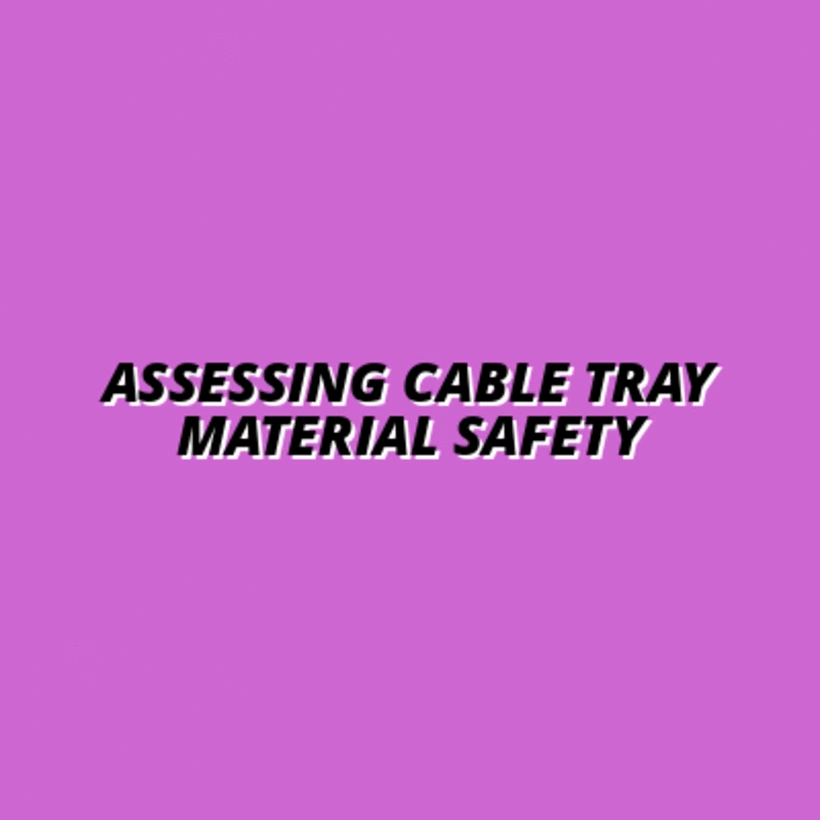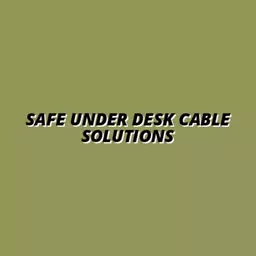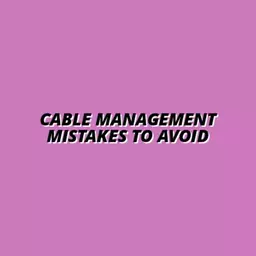
Assessing Cable Tray Material Safety
In today's fast-paced work environments, effective cable management is more than just a neat appearance; it's a critical safety concern. Understanding the nuances of cable tray safety can make the difference between a compliant, efficient workspace and one fraught with hazards. Are you ready to enhance your knowledge and transform your workspace?
Key Takeaways
- Understanding cable tray safety standards is essential to ensure compliance, protect wiring, and prevent accidents.
- Material selection is crucial; choosing the right materials can enhance durability and prevent overheating or electrical failures.
- Regular inspections of cable trays and cables are necessary to maintain safety and functionality in your workspace.
- Staying informed about regulatory trends and advancements in smart technologies can help improve cable tray safety and compliance.
- Consulting with experienced professionals for installation and inspection can ensure adherence to safety standards and best practices.
Key Aspects of Cable Tray Safety and Material Evaluation
Understanding cable tray safety involves compliance, material evaluation, and ongoing education to enhance workspace safety and efficiency. Below are key points to consider:
Safety Standards
- Load capacity
- Environmental considerations
- Material specifications
Material Evaluation
- Durability impacts longevity
- Resistance to environmental factors
- Prevention of hazards like overheating
Regular Inspections
Routine inspections help maintain safety and functionality in cable management systems.
Future Considerations
- Smart technologies for proactive maintenance
- Eco-friendly materials and designs
- Adapting to new safety guidelines
Understanding Cable Tray Safety: Importance and Overview
When it comes to organizing our workspaces, cable management isn't just about keeping things tidy; it's also about ensuring safety! At Under-Desk Tray Hub, we recognize that understanding cable tray safety is crucial for any installation. Cable trays are essential for holding and organizing electrical and telecommunication cables, but they must be used correctly to prevent hazards. So, let’s dive into why safety standards are vital in this context.
Proper cable tray safety standards not only protect your wiring but also help ensure compliance with regulations that could keep your workspace secure. Without these standards, you risk creating situations that could lead to accidents or even fires. It’s important to know what guidelines exist and how they apply to your particular setup. By understanding these aspects, you can create a safer and more efficient workspace.
Defining Cable Tray Safety Standards
Now, what exactly do we mean by cable tray safety standards? These are established regulations that dictate how cable trays should be designed, constructed, and installed. Key standards include guidelines from organizations like the National Electrical Manufacturers Association (NEMA) and the National Fire Protection Association (NFPA). Here are a few important points to consider:
- Each standard focuses on aspects like load capacity, environmental considerations, and material specifications.
- Compliance with these standards helps ensure safety during installation and regular use.
- Failing to meet safety standards can lead to legal repercussions and increased liability.
As someone who is passionate about workspace organization, I always emphasize that adhering to safety standards in cable management is not just a choice but a necessity. By doing so, we protect not only our equipment but also the people who use the workspace! For further reading, explore safe cable tray practices to enhance your understanding of these critical guidelines.
Why Evaluating Cable Tray Materials Matters
Choosing the right materials for your cable tray is a game-changer in terms of both safety and performance. Different materials come with unique properties that can enhance or compromise the effectiveness of your cable management solutions. For instance, metal trays may provide better durability, while plastic trays could be more lightweight and cost-effective. Here’s why material evaluation is crucial:
- Material durability impacts the longevity of your cable trays, reducing the need for frequent replacements.
- Some materials offer better resistance to environmental factors, which can be essential based on your workspace.
- Evaluating materials can prevent potential hazards such as overheating or electrical failures.
At Under-Desk Tray Hub, we believe that a well-informed selection of cable tray materials can significantly enhance workspace efficiency and safety. Understanding the properties of different materials will empower you to make educated decisions that lead to a better organized and safer working environment.
Pro Tip
Did you know? Regularly reviewing and updating your cable management strategy can significantly reduce safety risks. Consider scheduling annual evaluations of your cable trays and their materials to ensure they still meet current safety standards and environmental needs.
💡 Want to master under-desk cable trays? Start with our foundational guide to all things cable management. 👉 Read the Cable Management 101 Guide
FAQs About Cable Tray Safety
What are cable tray safety standards?
Cable tray safety standards are regulations that dictate the design, construction, and installation of cable trays to ensure safety and compliance. Organizations like NEMA and NFPA provide key guidelines.
Why is material evaluation important for cable trays?
Evaluating cable tray materials is crucial because different materials have unique properties that affect durability, environmental resistance, and safety. Choosing the right material can prevent hazards like overheating and electrical failures.
What are the benefits of regular cable tray inspections?
Regular inspections help maintain the safety and functionality of cable management systems by identifying potential issues early, ensuring compliance, and preventing accidents.
How can smart technologies improve cable tray safety?
Smart technologies, such as monitoring systems, can provide real-time insights into cable tray conditions, enabling proactive maintenance and preventing potential safety issues.
Why should I consult professionals for cable tray installation and inspection?
Consulting professionals ensures that your cable tray systems are installed correctly and comply with safety standards. Experts can provide valuable insights and recommendations for optimizing your workspace safety.
Conclusion: Key Takeaways on Evaluating Cable Tray Safety
As we wrap up our discussion on cable tray safety, it's clear that understanding compliance and material selection is vital. Evaluating the materials and ensuring that they meet safety standards can significantly reduce risks associated with cable management. I want to emphasize that choosing the right cable tray isn't just about aesthetics; it’s about creating a safe and functional workspace! For more on this, see these DIY cable management tips to keep your workspace tidy and safe.
When selecting cable trays, consider the following points to ensure safety and compliance:
- Safety Certifications: Always look for products that have national safety certifications such as CCC, NEMA, and OSHA.
- Material Properties: Opt for materials that ensure structural integrity, corrosion resistance, and fire safety.
- Regular Inspections: Implement a routine for inspecting cables and trays to maintain safety and functionality.
Future Considerations and Regulatory Trends Impacting Safety
The landscape of cable tray safety is continually evolving, with new regulations and technologies emerging. As we look to the future, it's essential to stay informed about changes that may impact the standards we adhere to. For instance, advancements in smart monitoring systems can enhance safety by providing real-time insights into cable tray conditions.
Additionally, the push for eco-friendly materials and innovative designs is gaining traction. Here are some trends to keep an eye on:
- Smart Technologies: Integration of smart monitoring systems for proactive maintenance.
- Eco-Friendly Materials: Use of sustainable composites and nano-coatings for improved performance.
- Regulatory Updates: Adapting to new safety guidelines as they develop.
To learn more about upcoming trends, consider reading about enhancing safety through cable management.
Call to Action: Engage with Experts for Effective Solutions
Consulting Professionals for Installation and Inspection
At Under-Desk Tray Hub, we understand that navigating the complexities of cable tray safety can be daunting. That’s why consulting with professionals for installation and inspection is paramount. Experts can ensure that your workspace is not only organized but also compliant with all safety standards.
When engaging with experts, consider:
- Experience: Look for professionals with a solid track record in cable management systems.
- Certifications: Ensure that they are certified and knowledgeable about the latest regulations.
- Recommendations: Seek referrals from trusted sources or read online reviews.
Accessing Resources for Ongoing Education and Compliance Updates
Staying educated about cable tray safety and compliance is an ongoing process. I encourage you to access resources that provide the latest information on materials, trends, and regulations. These resources can help you make informed decisions that enhance your workspace's safety and efficiency.
Here are some ways to keep your knowledge up to date:
- Webinars and Workshops: Participate in events focusing on cable management best practices.
- Industry Publications: Subscribe to journals that cover cable management innovations and standards.
- Online Forums: Join communities where professionals share their insights and experiences.
By taking proactive steps to engage with experts and stay informed, you'll be well on your way to creating a safe and organized workspace. Let's get started on transforming your cable management strategy today!
Recap of Key Points
Here is a quick recap of the important points discussed in the article:
- Adhere to Safety Standards: Compliance with established safety standards like those from NEMA and NFPA is essential to prevent accidents and ensure a secure workspace.
- Evaluate Material Properties: Choose cable tray materials based on durability, environmental resistance, and safety to enhance performance and reduce risks.
- Regular Inspections: Implement a routine for inspecting cables and trays to maintain safety and functionality, minimizing potential hazards.
- Stay Informed: Keep up with emerging trends, such as smart technologies and eco-friendly materials, to ensure your cable management solutions are up-to-date.
- Consult Professionals: Engage with experts for installation and inspection to ensure compliance with safety standards and effective cable management.




